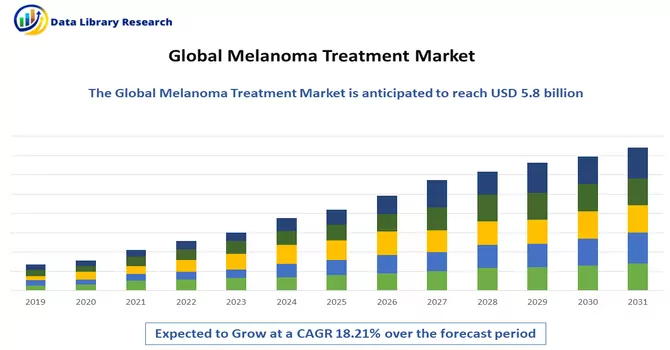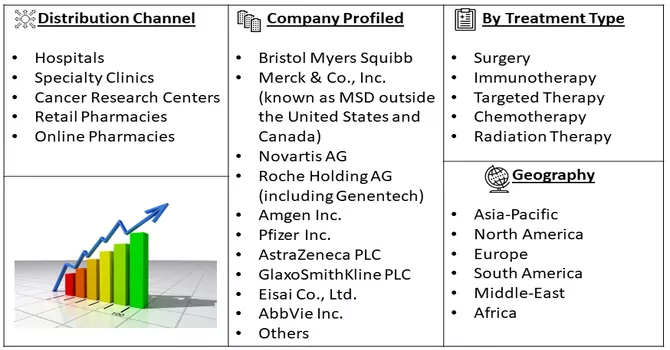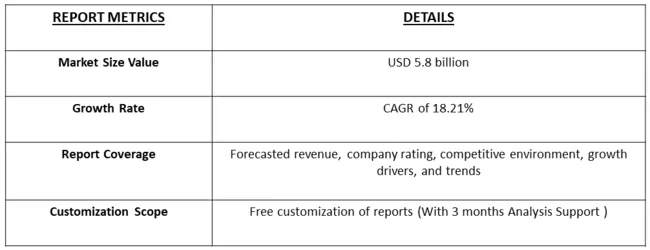The Melanoma Diagnostics and Therapeutics market is currently valued at USD 5.8 billion expected to register a CAGR of 18.21% over the forecast period, 2023-2031.

Get Complete Analysis Of The Report - Download Free Sample PDF
The melanoma treatment market is experiencing significant growth, driven by advancements in oncology research, innovative therapeutic approaches, and a growing incidence of melanoma cases worldwide. Melanoma, a type of skin cancer, has witnessed an increasing prevalence, necessitating a robust market for effective treatment modalities. Immunotherapy and targeted therapy have emerged as prominent contributors to the market, offering personalized and precise interventions for melanoma patients. The development of novel immunotherapeutic agents, such as immune checkpoint inhibitors, has transformed the landscape of melanoma treatment, improving survival rates and providing new hope for patients. Additionally, ongoing research into combination therapies and adjuvant treatments further propels market expansion. As the melanoma treatment market continues to evolve, collaboration between pharmaceutical companies, research institutions, and healthcare providers plays a pivotal role in shaping the future of effective and comprehensive melanoma care. A primary growth driving factor for the melanoma treatment market is the rapid advancements in immunotherapy and targeted therapy, offering more effective and personalized treatment options for melanoma patients. The development and widespread adoption of immune checkpoint inhibitors, such as PD-1 and CTLA-4 inhibitors, have significantly improved the prognosis for individuals with advanced melanoma. These therapies harness the body's immune system to target and eliminate cancer cells, showcasing unprecedented success in achieving durable responses. Additionally, the continuous exploration of targeted therapies, including BRAF and MEK inhibitors, tailored to specific genetic mutations in melanoma, further fuels market growth. As research efforts continue to uncover new therapeutic modalities and combination strategies, the evolving landscape of melanoma treatment is marked by increased efficacy, reduced side effects, and improved patient outcomes, establishing immunotherapy and targeted therapy as pivotal growth drivers in the melanoma treatment market.
Market Segmentation: The melanoma treatment market can be segmented by Distribution Channel: (Hospitals, Specialty Clinics, Cancer Research Centers, Retail Pharmacies and Online Pharmacies) Treatment Type: (Surgery, Immunotherapy, Targeted Therapy, Chemotherapy and Radiation Therapy ) and Geography (North America, Europe, Asia Pacific, Middle East and Africa, and South America). The market provides the value (in USD million) for the above-mentioned segments.

For Detailed Market Segmentation - Download Free Sample PDF
The melanoma treatment market is witnessing several noteworthy trends that are reshaping the landscape of skin cancer therapeutics. A prominent trend is the increasing emphasis on combination therapies, where immune checkpoint inhibitors are paired with targeted therapies or other immunomodulatory agents, aiming for enhanced treatment efficacy. Moreover, precision medicine is gaining traction, with a growing focus on identifying specific genetic mutations in melanoma tumors to tailor therapies accordingly. The emergence of novel biomarkers for patient stratification and treatment response monitoring is another significant trend, contributing to more personalized and effective melanoma care. Additionally, advancements in early detection technologies and the development of adjuvant therapies are shaping a comprehensive approach to melanoma treatment. The collaborative efforts between pharmaceutical companies and research institutions, along with a rising awareness of melanoma's genomic complexity, underscore the dynamic nature of market trends, fostering innovation and improved outcomes in the evolving landscape of melanoma treatment.
Market Drivers:
The rapid progress in immunotherapy
The rapid progress in immunotherapy stands as a pivotal driver for the melanoma treatment market, ushering in a transformative era in cancer care. Characterized by the development and widespread adoption of immune checkpoint inhibitors, this innovative therapeutic approach has revolutionized melanoma treatment. Immune checkpoint inhibitors, such as PD-1 and CTLA-4 inhibitors, empower the immune system to recognize and target cancer cells effectively, leading to significant advancements in patient outcomes. The success of immunotherapy in achieving durable responses and improved survival rates has propelled its central role in melanoma treatment regimens, fostering optimism for patients and healthcare providers alike. As research continues to refine existing immunotherapies and explore novel combinations, the rapid progress in immunotherapy remains a key driver, reshaping the landscape of melanoma treatment and contributing to advancements in cancer care on a broader scale.
The escalating incidence of melanoma cases globally contributes to the expanding market
The escalating incidence of melanoma cases globally stands as a compelling driver for the expanding melanoma treatment market. With skin cancer rates on the rise, particularly in regions with high ultraviolet radiation exposure and changing lifestyle factors, there is an increasing healthcare burden associated with melanoma. The growing prevalence of this malignancy necessitates advanced and effective treatment options, propelling the demand for innovative therapeutic interventions. The expanding patient pool underscores the urgency to develop and provide accessible treatments that address the specific challenges posed by melanoma. This surge in cases not only contributes to the market's growth but also highlights the imperative for ongoing research, technological advancements, and collaborative efforts in the field of melanoma treatment to meet the rising global healthcare demand associated with this aggressive form of skin cancer.
Market Restraints:
The melanoma treatment market faces notable restraints that impact its trajectory. One significant challenge is the high cost associated with advanced immunotherapies and targeted therapies, limiting widespread accessibility and affordability for certain patient populations. Additionally, the potential for adverse side effects and immune-related toxicities with immunotherapy poses a constraint on its broader adoption. The complexity of melanoma, marked by genetic heterogeneity and evolving resistance mechanisms, presents a hurdle in developing universal and long-term effective treatments. Regulatory challenges and reimbursement issues further complicate market dynamics, influencing the availability and adoption of innovative therapies. Moreover, the ongoing COVID-19 pandemic has disrupted clinical trials and patient care, affecting the development and delivery of melanoma treatments. Addressing these restraints requires a multi-faceted approach involving collaboration between healthcare stakeholders, regulatory bodies, and industry players to enhance accessibility, manage treatment-related challenges, and navigate the dynamic landscape of melanoma therapeutics.
The COVID-19 pandemic has significantly impacted the melanoma treatment market, introducing challenges that have influenced both patient care and industry dynamics. The disruptions caused by the pandemic, including healthcare system strain, delayed diagnoses, and interruptions in clinical trials, have impeded the timely initiation and continuation of melanoma treatments. Restricted access to healthcare facilities, prioritization of COVID-19-related care, and patient hesitancy to seek medical attention during the pandemic have collectively contributed to delayed melanoma diagnoses and treatments. Additionally, the pandemic's effect on the global economy has influenced healthcare budgets, affecting reimbursement policies and patient affordability for advanced melanoma therapies. Despite these challenges, the heightened focus on healthcare resilience, accelerated digitization, and ongoing research efforts to address pandemic-induced setbacks are expected to contribute to the eventual recovery and continued growth of the melanoma treatment market in the post-COVID-19 era.
Segmental Analysis:
Cancer Research Centers is Expected to Witness Significant Growth Over the Forecast Period
Cancer research centers play a pivotal role in advancing the field of melanoma treatment through extensive research, clinical trials, and the development of innovative therapies. These centers serve as hubs for collaboration among scientists, oncologists, and healthcare professionals, facilitating the exchange of knowledge and expertise. They contribute significantly to the discovery of new treatment modalities, including immunotherapy, targeted therapy, and combination therapies, aimed at improving patient outcomes and survival rates. By conducting cutting-edge research and testing novel treatment approaches, cancer research centers drive progress in the field of melanoma treatment, ultimately leading to more effective and personalized therapeutic options for patients.
Radiation Therapy is Expected to Witness Significant Growth Over the Forecast Period
Radiation therapy is a crucial component of melanoma treatment, particularly for patients with locally advanced or metastatic disease. It utilizes high-energy radiation beams to target and destroy cancer cells, either as a primary treatment or in combination with surgery and/or chemotherapy. In melanoma, radiation therapy may be employed to shrink tumors, relieve symptoms, or eliminate cancer cells remaining after surgery. Advanced techniques such as intensity-modulated radiation therapy (IMRT) and stereotactic body radiation therapy (SBRT) allow for precise targeting of tumors while minimizing damage to surrounding healthy tissues. Additionally, emerging approaches like proton therapy offer the potential for further refining treatment accuracy and reducing side effects. As part of a multidisciplinary treatment approach, radiation therapy continues to play a vital role in improving outcomes for patients with melanoma.
North America Region is Expected to Witness Significant Growth Over the Forecast Period
In North America, the melanoma treatment market is characterized by advanced medical infrastructure, high healthcare expenditure, and a strong emphasis on research and development. The region boasts a significant prevalence of melanoma cases, particularly in regions with greater sun exposure. With a well-established healthcare system and access to cutting-edge treatment modalities, including immunotherapy, targeted therapy, and innovative surgical techniques, North America remains at the forefront of melanoma treatment. Moreover, the presence of key market players and academic institutions engaged in melanoma research contributes to the development of novel therapies and advancements in precision medicine. Clinical trials and collaborations between pharmaceutical companies, research institutions, and healthcare providers further drive innovation and adoption of new treatment approaches, ensuring that patients in North America have access to the latest advancements in melanoma care.

Get Complete Analysis Of The Report - Download Free Sample PDF
The analyzed market exhibits a high degree of fragmentation, primarily attributable to the presence of numerous players operating on both a global and regional scale. The competitive landscape is characterized by a diverse array of companies, each contributing to the overall market dynamics. This fragmentation arises from the existence of specialized solution providers, established industry players, and emerging entrants, all vying for market share. The diversity in market participants is underscored by the adoption of various strategies aimed at expanding the company presence. On a global scale, companies within the studied market are strategically positioning themselves through aggressive expansion initiatives. This often involves entering new geographical regions, targeting untapped markets, and establishing a robust global footprint. The pursuit of global expansion is driven by the recognition of diverse market opportunities and the desire to capitalize on emerging trends and demands across different regions. Simultaneously, at the regional level, companies are tailoring their approaches to align with local market dynamics. Regional players are leveraging their understanding of specific market nuances, regulatory environments, and consumer preferences to gain a competitive edge. This regional focus allows companies to cater to the unique needs of local clientele, fostering stronger market penetration. To navigate the complexities of the fragmented market, companies are implementing a range of strategies. These strategies include investments in research and development to stay at the forefront of technological advancements, mergers and acquisitions to consolidate market share, strategic partnerships for synergies, and innovation to differentiate products and services. The adoption of such multifaceted strategies reflects the competitive nature of the market, with participants continually seeking avenues for growth and sustainability. In essence, the high fragmentation in the studied market not only signifies the diversity of players but also underscores the dynamism and competitiveness that drive ongoing strategic maneuvers. As companies explore various avenues for expansion, the market continues to evolve, presenting both challenges and opportunities for industry stakeholders.
Some of the key market players are:
Recent Development:
1) In January 2022, Pfizer Inc. was granted approval by the United States Food and Drug Administration (FDA) for CIBINQO (abrocitinib), an oral, once-daily Janus kinase 1 (JAK1) inhibitor. This approval is for the treatment of adults with refractory, moderate-to-severe atopic dermatitis (AD) whose disease is not adequately controlled with other systemic drug products, including biologics, or when the use of those therapies is not recommended.
2) In January 2022, Immunocore received FDA approval for KIMMTRAK (tebentafusp-tebn) for the treatment of unresectable or metastatic uveal melanoma.
Q1. What is the current Melanoma Treatment Market size?
As per Data Library Research the Melanoma Diagnostics and Therapeutics market is currently valued at USD 5.8 billion.
Q2. At what CAGR is the market projected to grow within the forecast period?
Melanoma Treatment Market is expected to register a CAGR of 18.21% over the forecast period.
Q3. What are the factors driving the Melanoma Treatment market?
Key factors that are driving the growth include The rapid progress in immunotherapy and The escalating incidence of melanoma cases globally contributes to the expanding market.
Q4. Which region has the largest share of the Melanoma Treatment market? What are the largest region's market size and growth rate?
North America has the largest share of the market. For detailed insights on the largest region's market size and growth rate request a sample here.
Data Library Research are conducted by industry experts who offer insight on industry structure, market segmentations technology assessment and competitive landscape (CL), and penetration, as well as on emerging trends. Their analysis is based on primary interviews (~ 80%) and secondary research (~ 20%) as well as years of professional expertise in their respective industries. Adding to this, by analysing historical trends and current market positions, our analysts predict where the market will be headed for the next five years. Furthermore, the varying trends of segment & categories geographically presented are also studied and the estimated based on the primary & secondary research.
In this particular report from the supply side Data Library Research has conducted primary surveys (interviews) with the key level executives (VP, CEO’s, Marketing Director, Business Development Manager and SOFT) of the companies that active & prominent as well as the midsized organization
FIGURE 1: DLR RESEARH PROCESS

Extensive primary research was conducted to gain a deeper insight of the market and industry performance. The analysis is based on both primary and secondary research as well as years of professional expertise in the respective industries.
In addition to analysing current and historical trends, our analysts predict where the market is headed over the next five years.
It varies by segment for these categories geographically presented in the list of market tables. Speaking about this particular report we have conducted primary surveys (interviews) with the key level executives (VP, CEO’s, Marketing Director, Business Development Manager and many more) of the major players active in the market.
Secondary ResearchSecondary research was mainly used to collect and identify information useful for the extensive, technical, market-oriented, and Friend’s study of the Global Extra Neutral Alcohol. It was also used to obtain key information about major players, market classification and segmentation according to the industry trends, geographical markets, and developments related to the market and technology perspectives. For this study, analysts have gathered information from various credible sources, such as annual reports, sec filings, journals, white papers, SOFT presentations, and company web sites.
Market Size EstimationBoth, top-down and bottom-up approaches were used to estimate and validate the size of the Global market and to estimate the size of various other dependent submarkets in the overall Extra Neutral Alcohol. The key players in the market were identified through secondary research and their market contributions in the respective geographies were determined through primary and secondary research.
Forecast Model
